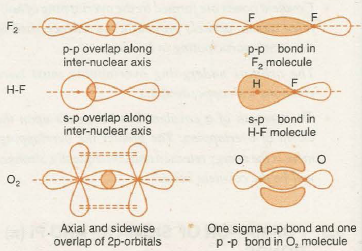Alkynes – the structure of triple bond (ethyne)
Ethyne is the simplest molecule of the alkyne series. In this case, each carbon atom is sp hybridized forming two sp hybrid orbitals. These two sp hybrid orbitals lie along the straight line and the bond angle between them is 180◦. The two unhybridized p orbitals are perpendicular to each other and also to the axis of the hybridized orbitals.
In the triple bond formation, on sp hybridized orbital of one carbon atom overlaps axially with the similar sp hybrid orbital of the other carbon atom to form a sigma bond. Each of the two unhybridized orbitals of one carbon overlaps sidewise with a similar orbital of the other carbon atom to form two weak π-bonds. The remaining sp hybrid orbital of each carbon atom overlaps with 1s orbital of hydrogen to form C-H bond. The structure of the triple bond is being illustrated by the orbital structure of ethyne as shown in the figure below:
Thus, carbon to carbon triple bond is made up of one sigma bond and two pi bonds. If one pi-electron cloud is visualized as lying above and below the internuclear axis representing sigma bond, the other pi electron clod lies in front and in back of the line as shown in the figure:

The overall orbital picture of the molecule is, that of a cylindrical electron cloud symmetrically distributed around the internuclear axis.
The electron diffraction studies have shown that the -C≡C- bond length is 120 pm and C-H bond length is 106 pm. While the H-C≡C- bond angle is 180◦, the strength of the -C≡C- bond is 823 kJ/mol.
Thus, the strength of the triple bond in alkyne is more than that of the double bond which is around 681 kJ/mol and C-C single bond about 348 kj/mol in alkanes. In fact, greater energy is released in the orbital overlap when the triple bond is formed than in the case of a double bond. It may be pointed out that carbon-carbon bond length in acetylene is 120 pm in comparison to 134 pm in ethane and 154 pm in ethane molecule. This means that C≡C is shorter than that of the C=C bond and C-C bond.
It has been explained on the basis of the extent of overlapping of orbitals. The C≡C bond involves the formation of one sigma and two pi bonds. For the formation of additional pi bond in acetylene as compared to ethylene, the bonding orbitals of carbon atoms have to come close together which results in shortening of bond distance. Moreover, the effective size of sp hybrid orbitals is smaller than that of hybrid orbitals. This also decreases the distance between the constituent carbon atoms.
The value of the bond angle and the orbital structure of alkynes clearly indicate that they are linear molecules. Hence, there is no restricted or hindered rotation about the triple bond. Alkynes, therefore do not show any geometrical isomerism. But it does show structural isomerism which are listed below.
- Chain isomerism: the isomers differ in the chain of carbon atoms.
- Position isomerism: alkynes having more than four carbon atoms show position isomerism.
- Functional isomerism: alkynes having four or more carbon atoms are functional isomers of dienes i.e., compounds having two double bonds.
- Ring chain isomerism: alkynes are isomeric with cycloalkenes containing the same number of carbon atoms. For example, propyne and cyclopropene.